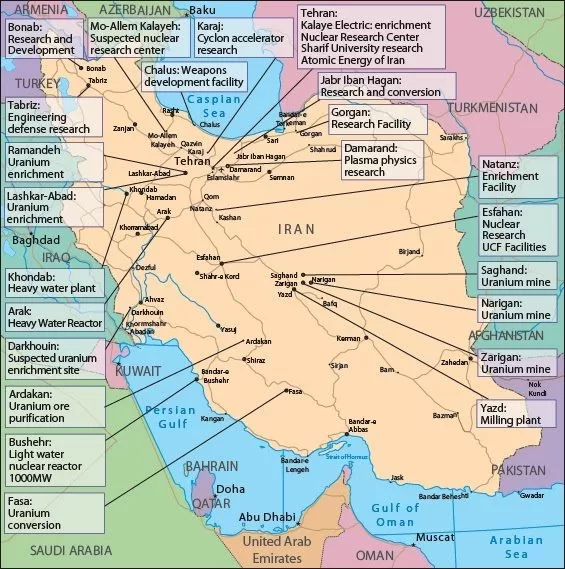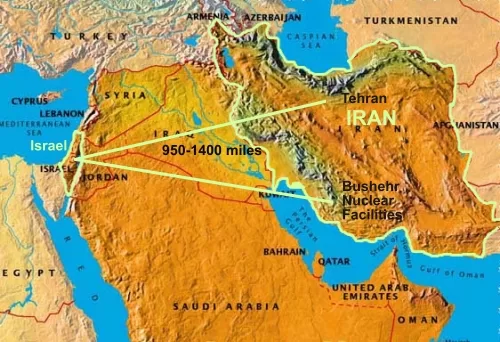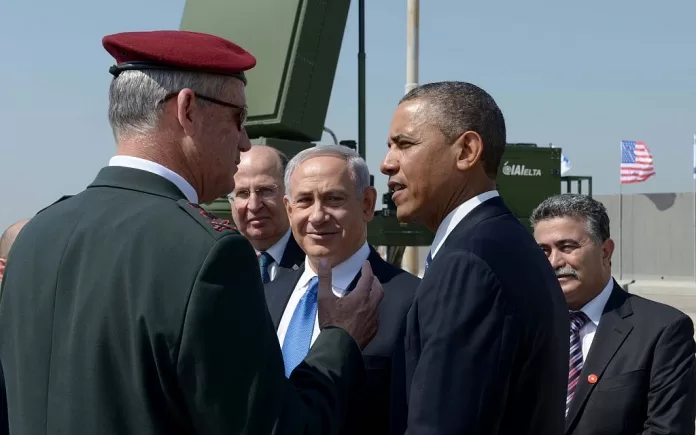Introduction
Recently, the hype in western media about an imminent attack by a joint US-Israeli enterprise in the coming spring has picked up again. Whether, the actual attack materializes or not, remains to be seen. As both the US and Israeli government elections are now over and given the quiet support shown by the Arab states, the chances of an adventure against the Iranian nuclear programme has not diminished. However, military, economic and geo-political situations within and outside United States make it a very complex and explosive undertaking. This article delves exclusively into the military options available to all sides and the likely consequences for the combatants and the region.
Likely Military Approaches by USA / Israel against Iran
A careful study of the Middle Eastern region and analysis of the Israeli military capabilities of engaging and destroying Iranian nuclear sites through air attacks reveals that an Israeli air assault on Iran’s nuclear infrastructure cannot sufficiently ensure setting back Iran’s march towards eventual nuclear weaponization, should it choose to do so. The order of battle (orbat) of Israeli Air Force (IAF) includes the latest F-16 and F-15 fighters backed by Air-Air refuellers (AAR), Electronic Intelligence (ELINT) aircraft and AWACS. IAF also possesses a variety of specialized standoff munitions like Joint Direct Attack Munitions (JDAMS), Paveway III Laser Guided Bombs (LGB), Precision Guided Munitions (PGM) and missiles etc.i
Almost all Iranian nuclear facilities are located somewhere between 750 – 950 NM from Israeli air bases. This means a round trip of approximately 1500 – 1800 NM for the attack aircraft flying through the airspaces of at least two Arab countries, encircling Israel. IAF F-16s with a full combat load of bombs and missiles coupled with max internal/external fuel cannot fly more than a total of 1100 – 1250 NM without refueling.ii This calculation does not consider combat allowances and emergency diversions etc.
To make a successful Iraqi OSIRAK style attempt, Israel would have to put air assets including AARs, AWACS, fighter escorts and ELINT systems along the multiple routes the attacking fighters are likely to take. This cannot be done without tacit support from the neighboring countries of Jordan, Syria, Iraq and Saudi Arabia. The invading packages cannot be expected to fight their way through the ground and interceptor based air defences of so many hostile countries, make it all the way to the targets, overcome the minefields of Surface-to-Air Missiles (SAMs) en route, deliver their payloads and successfully ward off a similar gauntlet on their return journey. While a one way trip akin to a near suicidal raid cannot be ruled out but under the circumstances it is at best a very remote probability.
Even if the logistical and tactical difficulties are somehow resolved, the problem remains of effectively neutralizing the surface and sub-surface nuclear facilities spread across Iran. Neither USA nor Israel possesses sufficient technological capability to achieve a high ‘Probability of Kill’ (Pk) against these facilities by air strikes with standard conventional munitions. This means that for a military solution with reasonable Pk, a combined multi-directional assault by different services of the armed forces would have to be undertaken. Besides arming the strike formations with special “bunker buster” bombs or the new massive ordnance penetrators (MOPs), the raid packages would have to include a combination of stealth assets, drones, Special Forces and cruise missiles along with cyber attack and subversive activities. Given the large number of nuclear sites to be targeted and their wide dispersion, multiple raids would have to be conducted to achieve the mission objective. Presently, only USA has the capability to mount multiple attacks from different directions against Iran from the Gulf, Arabian Sea, Afghanistan and Turkey.
If this option is exercised, US facilities around Iran, especially in the GCC states would get involved which would justifiably be viewed by Iran as a hostile action not only by USA but also by the GCC states. As a consequence, GCC states should be prepared for a tit-for-tat retaliation by Iranian forces against their economic and military targets.
In case of disastrous radiation fallouts affecting large swaths of Iranian population after the Israeli or US-Israel combine air bombardment, a desperate Iran, however remote it might appear, could on its own or through its surrogate Hezbollah, target Israel and US interests in the region with chemical weapons or even “dirty radiation bomb”.
Environmental Costs
Another problem confronting the planners of such an attack would be the possibility of nuclear fallout endangering surrounding populations both inside and outside Iran. As most of the Iranian nuclear sites by now have gone “hot”, such an outcome is very likely. With nuclear sites situated at Bushehr, Natanz, and Tehran etc. the possible humanitarian consequences would be grave and can have potentially long term harmful effects on neighbouring countries (GCC, Turkey, Central Asian Republics, Afghanistan and Pakistan) as well, as was witnessed in the aftermath of the Chernobyl disaster.iii This also has the potential of seriously contaminating portions of the Gulf, Arabian and Caspian seas. The destruction of Iraq’s OSIRAK cannot be cited as a precedence, as it was a single site, deep within the Iraqi desert and was still under construction when it was attacked and destroyed.
In case of a full scale or even a low intensity war from both sides, chances are high that oil installations and tankers sailing in Persian Gulf and Arabian Sea would get hit. Again, this could result in a serious environmental catastrophe for the entire region. Hence, the long term economic, ecological and humanitarian costs for all the surrounding countries would be significant and cannot be ignored.iv
Post Attack Military Options for Iran
In case of an attack by either USA/Israel or both against Iranian nuclear infrastructure, the retaliatory options for Iranian planners in the conventional arena are also very limited.
Ballistic and Cruise Missile Threat
Iran possesses considerable number of short and intermediate range ballistic missiles (SRBM/IRBM) with ranges from 300 – 2000 Kms and an unknown number of cruise missiles (mainly Chinese anti-ship versions), which can either be fired from naval vessels or land based fixed or mobile platforms.v The Iranian rocket force and its command & control are relatively well advanced as compared to the Iraqi Scuds that the Allied forces encountered in the 1991 Gulf War.
Iran’s SRBM and IRBM inventory would pose a potent and serious threat only if armed with Nuclear, Biological or Chemical (NBC) warheads. If these missiles are made to carry conventional explosives their impact would be superficial. Iranian mobile IRBMs with the range of 1000-2000 Kms have the flexibility of being fired from Tractor-Erector-Launchers (TERs) placed deep inside Iran against targets lying close to the Gulf thus making them harder to find and hit before launch and even post launch. On the other hand, these missiles carrying 1000 Kg each of conventional high explosives cannot do more than superficial damage to a well prepared military and command infrastructure. Their poor CEP makes them unsuitable for precision guided strikes and to make a considerable dent in an adversary’s military / oil facilities, hundreds of these missiles would have to be fired in salvos.vi

As Iran would have to attack widely dispersed facilities in Israel and GCC countries, the overall Iranian SRBM / IRBM effort would thin out considerably, making it both cost and operationally prohibitive for Iran. This is not to suggest that Iran would not retaliate using its missile forces, rather the practical value of such strikes would be more psychological and propagandistic than militaristic. Reported Iranian MIRV (Multiple Independent Re-entry Vehicles) capability on its IRBMs also does not pose a significant threat in a conventional setting. Israel and GCC states are well equipped with the latest Arrow and Patriot Anti Ballistic Missile (ABM) launchers, reducing the chances of missile related damage to their infrastructure even further.vii
One potentially disastrous outcome of a US military strike can be of radiation fallout around Iranian nuclear facilities with massive civilian causalities. In such a case, a chemically equipped Iran might be inclined to use its ballistic missile force tipped with chemical warheads, which would present a clear and present danger to GCC states and US / Israeli installations. However, the chances of an Iranian response using chemical weapons against the US or Israel are very slim, because both the US and Israel possess the capability of massive nuclear retaliation against Iran, if they come under unconventional attack from Iran’s side. A chemical attack by Iran might provide the US with the perfect excuse for using tactical nuclear weapons against the remaining targets inside Iran.
Iranian cruise missile batteries, posted either at Qashm, Kish, Kharg and Tunb Islands or on the mainland coast, have the potential of seriously disrupting the maritime traffic in and out of the Persian Gulf and especially within the narrow Strait of Hormuz. In case of an imminent attack by US / Israeli forces, these batteries would have to be neutralized by USA or GCC (but not necessarily Israel, as it is situated beyond the range of Iranian cruise missiles and does not use the Persian Gulf for its economic or military activities) to protect their maritime trade and assets.
Air Threat
Numerically, Iran has a moderately strong Air Force made up of old US and Soviet aircraft such as F-4, F-5, F-14, SU-24 and SU-25 aircraft. Qualitatively, its Air Force is far behind the 4 and 4+ generation aircraft of the US, Israel or GCC countries.viii It lacks proven standoff capability in both air-to-air and air-to ground / sea role. The training and tactical quality of its pilots cannot be commented upon because of lack of information and also because these traits are difficult to quantify.
The airlift capability of Iranian armed forces is substantial. The chances of an airborne attack by Iranian Special Forces on mainland GCC are slim owing to the overwhelming aerial monitoring and air defence capabilities of the US and GCC; however, attacks on isolated offshore facilities in the Gulf cannot be ruled out. Even, if the US air power is discounted, present orbat of the combined GCC Air Forces and their technological sophistication is sufficient to neutralize the Iranian air threat, especially when GCC aircraft would be fighting within their own air space.
Naval Threat
Iran operates a few Kilo class submarines along with a strong fleet of midget subs in support of its surface ships.ix However, due to very little maneuvering room and shallow depths within the Persian Gulf, these vessels may be used primarily to mine coastal waters inside and possibly outside the Gulf to restrict and disrupt Arab oil trade. Complete closure of the Gulf or Strait of Hormuz by Iran is unlikely due to various technical and political considerations; however, severe restrictions can be enforced by Iran through mining and anti ship operations by its smaller naval vessels and / or aircraft. During the Iran – Iraq war, crude attempts to inflict such punishments were made by both sides with mixed results. Such low intensity tactics, albeit at a greater and more sophisticated level than 1980s, are most likely to be favoured by the Iranian commanders to exact some form of revenge if Iranian nuclear facilities are targeted.
Conventional Threat from Iranian Land Forces
Although, the strongest conventional punch within the Iranian Armed forces is retained by its land forces (comprising Iranian Army, Islamic Revolutionary Guards (IRGC) and Basij troops), a classical infantry / armour assault against GCC or USA through Iraq is highly unlikely because these formations would suffer very high attrition and are unlikely to cause much damage to GCC or US interests in the region. Iran does not possess the means to undertake an amphibious assault across the Gulf – or at least Strait of Hormuz – against UAE in sizeable numbers; however, possibility of clandestine commando style raids against offshore or coastal facilities is still possible.
4GW / Asymmetric Threat
Perhaps, the most credible and worrisome threat may come from the Iranian use of non-state actors such as Hezbollah and its potential sleeper cells across the globe. Iran’s use of its ideologically indoctrinated Basij Militia for suicide attacks on shipping or oil installations is a very distinct possibility, while Hezbollah can make things very difficult for Israel and GCC as well, through covert and overt actions. Whether Hezbollah can mount attacks against US – Israeli – EU interests in the wider Mediterranean region is beyond the scope of this paper; however, US and Israeli planners would have to give this possibility some consideration within their overall planning framework.x
Iran has wide expertise of using these outfits in both conventional and unconventional roles – Basij in the conflict against Iraq, IRGC against USA in Iraq and Hezbollah against Israelxi – and also operates a wide network of Human Intelligence (HUMINT) assets within GCC states. Together, these three organizations make the most potent arm of Iranian military power. Its members are battle hardened, highly trained, and well motivated and for a national cause such as the security of the nuclear programme are likely to fight with fanatical zeal.
Due to its close proximity with Iran, UAE’s on and offshore installations and shipping are vulnerable to sneak suicide or IED attacks carried out by dedicated individuals, especially at night. A busy maritime thoroughfare such as the Gulf or the Strait of Hormuz is a vulnerable spot, where hundreds of legitimate small Skiffs, Yachts and local fishing boats are operating at any given time. With a determined and well trained Iranian assault team, the possibility of successful sneak-in attacks by explosive packed small boats close to a ship or installation (in the style of USS Cole) is high.

Analysis
For as long as US/Israel – Iran standoff continues, Iran’s neighbours (Afghanistan, Pakistan and GCC States) will remain vulnerable to serious security threats. Pakistan’s strategic imperative to have a friendly neighbor in the West i.e. Iran, will have to surmount major obstacles from USA and Saudi Arabia. Pakistan’s efforts to increase trade, especially with energy rich Iran is currently being suffocated by USA. The financial health of GCC (mainly UAE) meanwhile is being affected by the US sponsored Iranian economic sanctions while an attack on Iran will pose major challenges to their security.
In the current environment while an armed US-Israel combined military campaign cannot be ruled, given the difficulties and complexities as elaborated earlier it is considered a low probability. However, if Iran is perceived to be continuing its march towards nuclear weaponization and appears close to achieving the goal, the likelihood of an armed intervention increases significantly, which will have disastrous economic and security consequences for the whole region, besides creating a major negative impact on global economy. It is in the world’s interest to dissuade US and Israel from contemplating a military assault on Iran, while trying to persuade the latter to convince the world body that its nuclear programme – as Iran continuously professes – has no weaponization component. Opening its fuel enrichment activities to full IAEA inspections is the way out for an end to the current impasse.
The economic repercussions of a military conflict in Persian Gulf will dwarf the “Oil Shock” the world experienced way back in 1974 due to the Arab oil embargo that more than quadrupled the oil prices and thoroughly shook the global economy. Economic sanctions can work up to a certain limit, but if it leads to strangulation of Iran’s economy, it may actually accelerate the nuclear weapons drive by Iran as an act of desperation.
End Notes
iFederation of American Scientists, (2000, May 24) Israel Air Force, retrieved from http://www.fas.org/nuke/guide/israel/agency/iaf.htm
Details extrapolated from the Flight Manual of Lockheed Martin F-16 Block 52+ Aircraft
iiFlanary, Will and Mcgill, Mark (2008, Dec 15) Environmental effects of the Chernobyl accident, retrieved from http://www.eoearth.org/article/Environmental_effects_of_the_Chernobyl_accident
iiiCordesman, Anthony H. (1988, Sep 09) The Tanker War and The Lessons of Naval Conflict, retrieved from http://csis.org/files/media/csis/pubs/9005lessonsiraniraqii-chap14.pdf
ivCrail, Peter (2012, Jan 01) Worldwide Missile Inventories, retrieved from http://www.armscontrol.org/factsheets/missiles
vStillion, John and Orletsky, David T. (1999) Airbase Vulnerability to Conventional Cruise-Missile and Ballistic-Missile Attacks, retrieved from http://www.rand.org/pubs/monograph_reports/2006/MR1028.pdf
viGale, Ivan (2011, Jun 29) UAE aids upgrade of Raytheon’s Patriot missile system, retrieved from http://www.thenational.ae/business/technology/uae-aids-upgrade-of-raytheons-patriot-missile-system
viiList of Aircraft of the Iranian Air force, retrieved from http://en.wikipedia.org/wiki/List_of_aircraft_of_the_Iranian_Air_Force
viiiList of current ships of the Islamic Republic of Iran Navy, retrieved from http://en.wikipedia.org/wiki/List_of_current_ships_of_the_Islamic_Republic_of_Iran_Navy
ixShanker, Thom. Cooper, Helene and Bronner, Ethan. (2012, Feb 29) U.S. Sees Iran Attacks as Likely if Israel Strikes retrieved from http://www.nytimes.com/2012/02/29/world/middleeast/us-sees-iran-attacks-as-likely-if-israel-strikes.html?pagewanted=all
xKarlin, Mara E. (2010, May 13) Lebanon’s Scud Row: Why Hezbollah Will Stay Armed and Dangerous retrieved from http://www.foreignaffairs.com/articles/66413/mara-e-karlin/lebanons-scud-row
All Websites accessed on 10 June, 2012.




